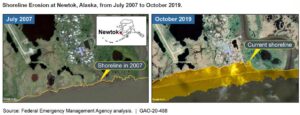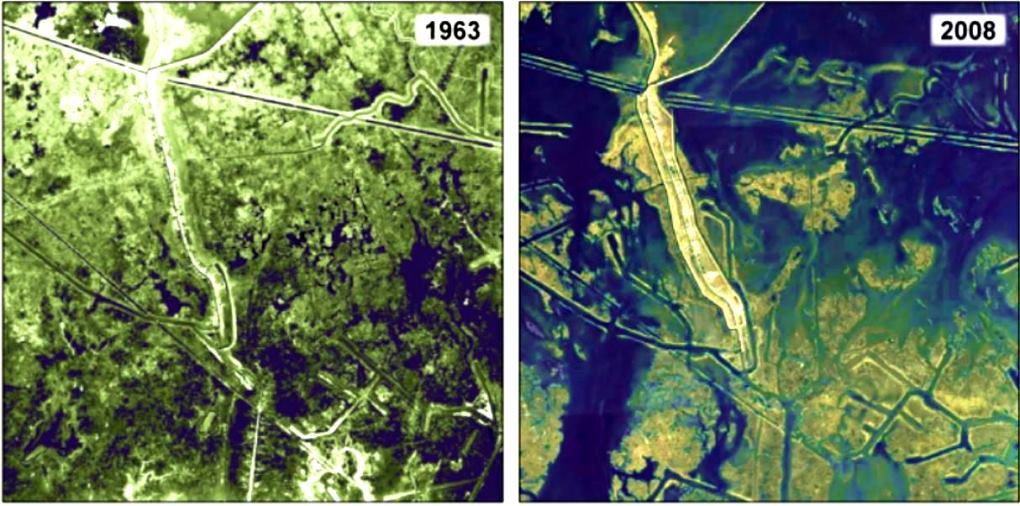While many federal agencies in the Trump administration have fallen in line with the Republican Senate’s denial of climate science—even to the point of banning the use of the term “climate change” in government reports—the U.S. Government Accountability Office (GAO) is apparently trying hard to live up to its mandate of providing truthful, accurate information on which to base decisions.
This is especially important when lives are at stake, and—in this case—the future of a substantial portion of the American economy as well.
Now, in July of 2020, the GAO recommended that “Congress should consider establishing a pilot program with leadership from a defined federal organizational arrangement to identify and provide assistance to climate migration projects for communities that express affirmative interest in relocation as a resilience strategy.” Bureaucrats aren’t often cited for their heroism, but the GAO qualify with this politically courageous action.
GAO’s research identified very few communities in the United States that have responsibly considered climate migration as a resilience strategy, and only two—Newtok, Alaska, and Isle de Jean Charles, Louisiana—that actually moved forward with relocation.
For more communities to devise realistic approaches to their future, they will need a strategic renewal process, as described in the new (2020) book, RECONOMICS, The Path To Resilient Prosperity. That’s the sort of approach that would likely require the involvement of a Certified Revitalization & Resilience Facilitator (RRFac).
 Newtok, for example, faced imminent danger from shoreline erosion due to thawing permafrost and storm surge (see figure at left). Literature and experts suggest that many more communities will need to consider relocating in coming decades.
Newtok, for example, faced imminent danger from shoreline erosion due to thawing permafrost and storm surge (see figure at left). Literature and experts suggest that many more communities will need to consider relocating in coming decades.
The GAO explained “Sea level rise due to climate change threatens areas where millions of Americans live. In all but the lowest projections, retreat or relocation of communities from coastal areas will be unavoidable, according to the U.S. Global Change Research Program. One way to prepare is to preemptively move away from vulnerable areas. But few communities have considered such climate migration. There is some related federal funding, but it’s hard to use for climate migration because the programs are designed to address other priorities.”
“We recommended Congress consider establishing a federally-led pilot program to help communities interested in relocation,” they concluded.
Such a pilot program could be designed for success by considering the key factors the GAO identified in their new report.
Here’s how the GAO describes why they issued this report:
Federal programs provide limited support to climate migration efforts because they are designed to address other priorities, according to literature GAO reviewed and interviews with stakeholders and federal officials. Federal programs generally are not designed to address the scale and complexity of community relocation and generally fund acquisition of properties at high risk of damage from disasters in response to a specific event such as a hurricane.
Unclear federal leadership is the key challenge to climate migration as a resilience strategy. Because no federal agency has the authority to lead federal assistance for climate migration, support for climate migration efforts has been provided on an ad hoc basis.
For example, it has taken over 30 years to begin relocating Newtok and more than 20 years for Isle de Jean Charles, in part because no federal entity has the authority to coordinate assistance, according to stakeholders in Alaska and Louisiana. These and other communities will rely on post-disaster assistance if no action is taken beforehand—this increases federal fiscal exposure. Risk management best practices and GAO’s 2019 Disaster Resilience Framework suggest that federal agencies should manage such risks before a disaster hits.
A well-designed climate migration pilot program that is based on project management best practices could improve federal institutional capability. For example, the interagency National Mitigation Investment Strategy—the national strategy to improve resilience to disasters—recommends that federal agencies use pilot programs to demonstrate the value of resilience projects.
As GAO reported in October 2019, a strategic and iterative risk-informed approach for identifying and prioritizing climate resilience projects could help target federal resources to the nation’s most significant climate risks. A climate migration pilot program could be a key part of this approach, enhancing the nation’s climate resilience and reducing federal fiscal exposure.
According to the 13-agency United States Global Change Research Program, relocation due to climate change will be unavoidable in some coastal areas in all but the very lowest sea level rise projections. One way to reduce the risks to these communities is to improve their climate resilience by planning and preparing for potential hazards related to climate change such as sea level rise. Climate migration—the preemptive movement of people and property away from areas experiencing severe impacts—is one way to improve climate resilience.
GAO was asked to review federal support for climate migration. This report examines (1) the use of climate migration as a resilience strategy; (2) federal support for climate migration; and (3) key challenges to climate migration and how the federal government can address them.
GAO conducted a literature review of over 52 sources and interviewed 12 climate resilience experts. In addition, GAO selected and interviewed 46 stakeholders in four communities that have considered relocation: Newtok, Alaska; Santa Rosa, California; Isle de Jean Charles, Louisiana; and Smith Island, Maryland.
Congress should consider establishing a pilot program with clear federal leadership to identify and provide assistance to communities that express affirmative interest in relocation as a resilience strategy. The Departments of Homeland Security and Housing and Urban Development provided technical comments that GAO incorporated as appropriate.
Featured image of Isle de Jean Charles, Louisiana is courtesy of U.S. Geological Survey.

